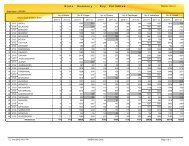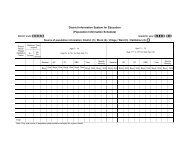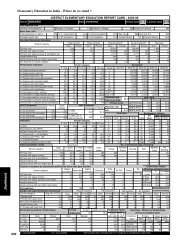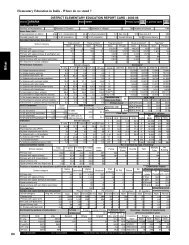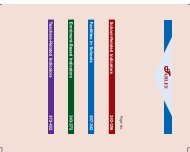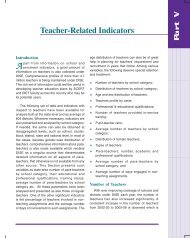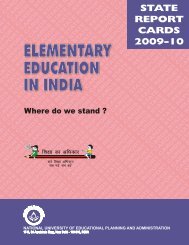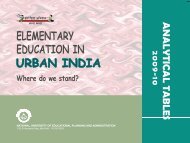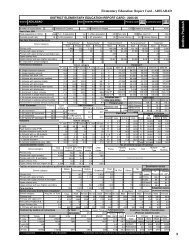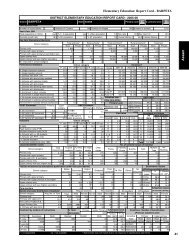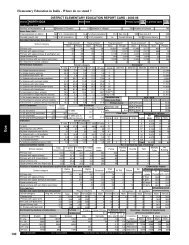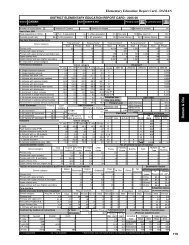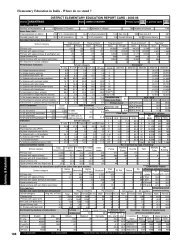Teacher Related Indicators & EDI - DISE
Teacher Related Indicators & EDI - DISE
Teacher Related Indicators & EDI - DISE
You also want an ePaper? Increase the reach of your titles
YUMPU automatically turns print PDFs into web optimized ePapers that Google loves.
<strong>Teacher</strong>-<strong>Related</strong> <strong>Indicators</strong><br />
Part IV<br />
states. On the other hand, in a few states, such as Andhra<br />
Pradesh, Chandigarh, Delhi, Puducherry, Punjab,<br />
Rajasthan, Uttar Pradesh and Uttarakhand, the majority<br />
(above 50 percent) of Primary school teachers is<br />
Graduates and above. Uttarakhand has more Post-<br />
Graduate Primary school teachers (35.92 percent) than<br />
teachers having Graduate degrees (31.47 percent) and<br />
the percentage of such female teachers is more than<br />
their male counterparts.<br />
Percentage of teachers by professional qualification<br />
(excluding para-teachers) presented in Tables D-16 and<br />
D-17 suggests that about 41.36<br />
percent male and 37.68 percent<br />
female teachers (all categories)<br />
in urban areas are B.Ed or<br />
equivalent, compared to 31.68<br />
percent male and 27.67 percent<br />
female teachers in rural areas.<br />
The total of these two shows<br />
that 38 and 30 percent teachers,<br />
respectively, in urban and rural<br />
areas have such degrees. It has<br />
also been noticed that<br />
percentage of such teachers in<br />
urban areas is higher than the<br />
same in rural areas. The<br />
corresponding figures in the case<br />
of teachers at Primary level are<br />
27.76 percent male and 27.68 percent female (total<br />
27.71 percent). In the case of integrated Higher<br />
Secondary schools, as many as 44.44 percent male and<br />
47.32 percent female teachers had B.Ed or equivalent<br />
degree in 2007-08, compared to 46.05 percent in the<br />
case of all teachers. Upper Primary attached to<br />
Secondary and Higher Secondary schools also have<br />
61.35 percent (61.14 male and 61.71 female) teachers<br />
with B.Ed degree. Further, it is noticed that compared<br />
to teachers having B.Ed degree, the percentage of<br />
teachers having M.Ed degree across school types is low.<br />
On the other hand, a good number of teachers are J.B.T<br />
or equivalent which is true for all categories and Primary<br />
teachers. Considering all teachers together, only 1.20<br />
percent teachers in Primary schools have M.Ed or<br />
equivalent degree compared to 1.84 percent in<br />
independent Elementary, 3.88 percent in integrated<br />
Higher Secondary, 2.98 percent in Upper Primary and<br />
“Percentage of teachers by<br />
professional qualification<br />
suggests that about<br />
41.36 percent male and<br />
37.68 percent female<br />
teachers in urban areas<br />
are B.Ed or equivalent,<br />
compared to 31.68 percent<br />
male and 27.67 percent<br />
female teachers in<br />
rural areas”<br />
3.97 percent in Upper Primary attached to Secondary<br />
and Higher Secondary schools.<br />
The percentage of no response in each school<br />
category indicates that a fairly good number of regular<br />
teachers do not possess any professional qualification.<br />
The percentage of such teachers (both regular and parateachers)<br />
is 22.32, compared to 19.10 percent in the<br />
case of regular teachers of all categories. The state-wise<br />
percentage of teachers with professional qualifications<br />
is presented in Table D-18. It reveals that about 78<br />
percent of the total teachers at Elementary level possess<br />
one or the other professional<br />
qualification, compared to 45<br />
percent in the case of parateachers.<br />
In the case of regular<br />
teachers alone, the percentage<br />
is as high as 81. The statespecific<br />
percentages reveal that<br />
the majority of regular teachers<br />
in all the north-eastern states,<br />
including Assam as well as in<br />
Jammu and Kashmir and in a few<br />
other states is yet to attain<br />
professional qualification. This is<br />
also true for para-teachers. On<br />
the other hand, in a few states,<br />
like Delhi, Kerala, Karnataka,<br />
Maharashtra, Rajasthan and<br />
Tamil Nadu, the majority of para-teachers are<br />
professionally trained; the majority of regular teachers<br />
in such states are also trained.<br />
In-Service Training of <strong>Teacher</strong>s<br />
As many as 2.07 million teachers had undergone<br />
in-service training in 2006-07 compared to 1.69 million<br />
in 2005-06. In other words, about 38.32 percent male<br />
and 35.80 percent female teachers (all categories) were<br />
imparted in-service training during the year 2006-07,<br />
compared to 33.22 percent male and 32.30 percent<br />
female teachers in 2005-06. In percentage terms, more<br />
female teachers were imparted in-service training than<br />
their male counterparts in both rural and urban areas.<br />
More than 71 percent of teachers in Gujarat (males<br />
79.13 percent and females, 64.03 percent) underwent<br />
in-service training, the highest amongst all the states.<br />
175




